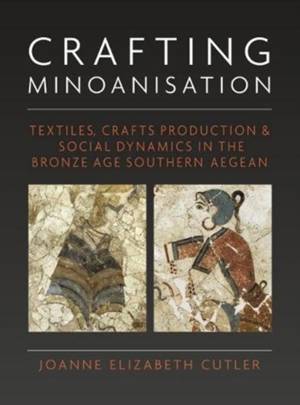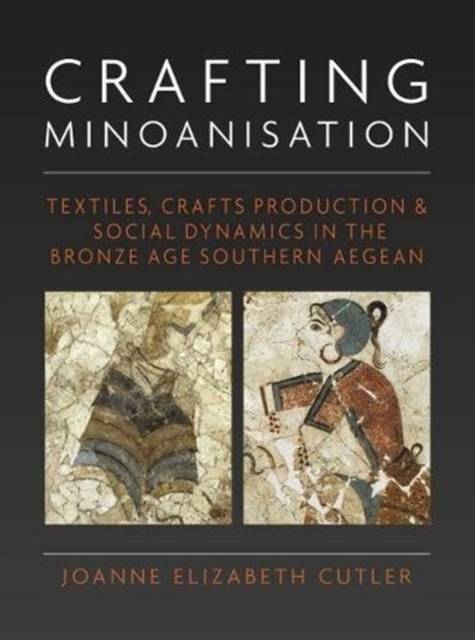
En raison d'une grêve chez bpost, votre commande pourrait être retardée. Vous avez besoin d’un livre rapidement ? Nos magasins vous accueillent à bras ouverts !
- Retrait gratuit dans votre magasin Club
- 7.000.000 titres dans notre catalogue
- Payer en toute sécurité
- Toujours un magasin près de chez vous
En raison de la grêve chez bpost, votre commande pourrait être retardée. Vous avez besoin d’un livre rapidement ? Nos magasins vous accueillent à bras ouverts !
- Retrait gratuit dans votre magasin Club
- 7.000.0000 titres dans notre catalogue
- Payer en toute sécurité
- Toujours un magasin près de chez vous
Crafting Minoanisation
Textiles, Crafts Production & Social Dynamics in the Bronze Age Southern Aegean
Joanne Elizabeth Cutler
80,45 €
+ 160 points
Description
The mid second millennium BC material record of the southern Aegean shows evidence of strong Cretan influence. This phenomenon has traditionally been seen in terms of 'Minoanisation', but the nature and degree of Cretan influence, and the process/processes by which it was spread and adopted, have been widely debated. This new study addresses the question of 'Minoanisation' through a study of the adoption of Cretan technologies in the wider southern Aegean: principally, weaving technology.
By the early Late Bronze Age, Cretan-style discoid loom weights had appeared at a number of settlements across the southern Aegean. In most cases, this represents not only the adoption of a particular type of loom weight, but also the introduction of a new weaving technology: the use of the warp-weighted loom. The evidence for, and the implications of, the adoption of this new technology is examined. Drawing upon recent advances in textile experimental archaeology, the types of textiles that are likely to have been produced at a range of sites both on Crete itself and in the wider southern Aegean are discussed, and the likely nature and scale of textile production at the various settlements is assessed.
A consideration of the evidence for the timing and extent of the adoption of Cretan weaving technology in the light of additional evidence for the adoption of other Cretan technologies is used to gain insight into the potential social and economic strategies engaged in by various groups across the southern Aegean, as well as the motivations that may have driven the adoption and adaptation of Cretan cultural traits and accompanying behaviors. By examining how technological skills and techniques are learned and considering possible mechanisms for the transmission of such technical knowledge and know-how, new perspectives can be proposed concerning the processes through which Cretan techniques were taken up and imitated abroad.
By the early Late Bronze Age, Cretan-style discoid loom weights had appeared at a number of settlements across the southern Aegean. In most cases, this represents not only the adoption of a particular type of loom weight, but also the introduction of a new weaving technology: the use of the warp-weighted loom. The evidence for, and the implications of, the adoption of this new technology is examined. Drawing upon recent advances in textile experimental archaeology, the types of textiles that are likely to have been produced at a range of sites both on Crete itself and in the wider southern Aegean are discussed, and the likely nature and scale of textile production at the various settlements is assessed.
A consideration of the evidence for the timing and extent of the adoption of Cretan weaving technology in the light of additional evidence for the adoption of other Cretan technologies is used to gain insight into the potential social and economic strategies engaged in by various groups across the southern Aegean, as well as the motivations that may have driven the adoption and adaptation of Cretan cultural traits and accompanying behaviors. By examining how technological skills and techniques are learned and considering possible mechanisms for the transmission of such technical knowledge and know-how, new perspectives can be proposed concerning the processes through which Cretan techniques were taken up and imitated abroad.
Spécifications
Parties prenantes
- Auteur(s) :
- Editeur:
Contenu
- Nombre de pages :
- 312
- Langue:
- Anglais
- Collection :
- Tome:
- n° 33
Caractéristiques
- EAN:
- 9781785709661
- Date de parution :
- 17-09-21
- Format:
- Livre relié
- Format numérique:
- Genaaid
- Dimensions :
- 288 mm x 221 mm
- Poids :
- 1352 g

Les avis
Nous publions uniquement les avis qui respectent les conditions requises. Consultez nos conditions pour les avis.






